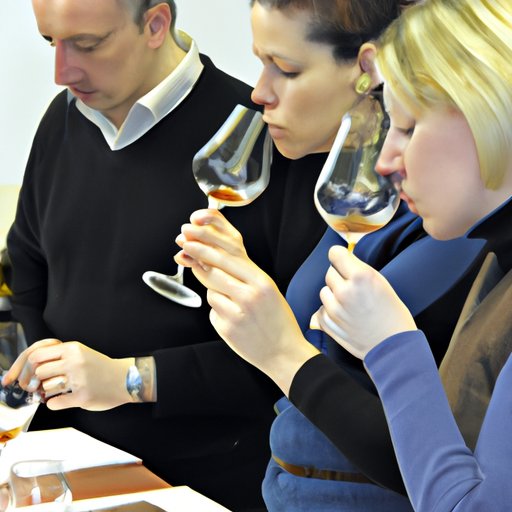Introduction
Wine tasting is more than just enjoying a glass of your favorite red or white. It’s an art that requires knowledge and skill to appreciate the nuances and complexities of each wine. In this article, we explore how does wine tasting work, from the process and techniques to the etiquette and food and wine pairing tips.
An Overview of Wine Tasting: Exploring the Process and Techniques
What is wine tasting? Simply put, it’s the act of sampling different types of wines in order to evaluate their characteristics. Professional wine tasters use a combination of sight, smell, and taste to identify and analyze the various elements present in the wine.
The process and techniques of wine tasting vary depending on the style. Generally speaking, the process includes swirling the glass, taking a sip, and evaluating the taste. The goal is to get an understanding of the wine’s aroma, flavor, body, and finish.
How to Taste Wine Like a Professional: Understanding the Basics
To get started, it’s important to understand the basics of wine tasting. Here are the steps you should follow to ensure you’re tasting the wine correctly:
Swirling the glass
The first step is to swirl the wine in the glass for a few seconds. Swirling helps to release the aromas and allows you to observe the appearance of the wine.
Taking a sip
Once you’ve swirled the glass, take a small sip of the wine. Allow the wine to coat your tongue and remain in your mouth for a few seconds before swallowing. This will help you to identify the flavors and textures of the wine.
Evaluating the taste
After taking a sip, evaluate the taste. Pay attention to the sweetness, acidity, tannins, and any other flavors you may detect. Consider the overall balance of the wine and the length of the finish.

Learn the Different Styles of Wine Tasting: From Formal to Informal
There are two main styles of wine tasting: formal and informal. Formal wine tasting usually involves a panel of experts who use a specific format to rate each wine. The process is structured and highly analytical, and the experts use a scoring system to rate the wines.
Informal wine tasting, on the other hand, is less structured and often involves friends or family members gathering to sample a selection of wines. The focus is on conversation and enjoyment instead of analysis and scoring.
Take a Deep Dive into the Art of Wine Tasting: Using Sight, Smell, and Taste to Identify Characteristics
Now that you know the basics, let’s take a deeper dive into the art of wine tasting. By using sight, smell, and taste, you can identify the various elements present in the wine.
Sight
Start by looking at the color of the wine. Notice the intensity of the hue and any variations in the color. Also, note the clarity of the wine and if there are any sediment particles present.
Smell
Next, give the wine a good sniff. This will help you to identify the aromas and bouquet of the wine. Notice the intensity of the aromas and any nuances that stand out.
Taste
Finally, take a sip of the wine and pay attention to the flavors and textures. Notice the sweetness, acidity, tannins, and any other flavors you may detect. Consider the overall balance of the wine and the length of the finish.

The Etiquette of Wine Tasting: Knowing What Not to Do
While there are no hard and fast rules when it comes to wine tasting, there are certain etiquette guidelines you should adhere to. Here are some common etiquette rules to keep in mind:
- Be respectful of the wines and other tasters.
- Don’t be afraid to ask questions.
- Don’t be afraid to be honest with your opinions.
- Be mindful of your consumption.
Additionally, there are some things you should avoid doing. These include talking too much, dominating the conversation, being overly critical, and drinking too much.

Food and Wine Pairing: Enhancing Your Wine Tasting Experience
Food and wine pairing is an important part of the wine tasting experience. By pairing the right foods with the right wines, you can enhance the overall flavor of both. Here are some tips for pairing food and wine:
- Match the body and weight of the wine with the food.
- Balance the flavors of the dish and the wine.
- Consider the texture and intensity of the flavors.
- Choose complementary flavors.
Food and wine pairing can be intimidating, but with practice, you’ll be able to create delicious pairings that will enhance your wine tasting experience.
Conclusion
Wine tasting is an art that requires knowledge and skill to appreciate the nuances and complexities of each wine. In this article, we explored how does wine tasting work, from the process and techniques to the etiquette and food and wine pairing tips. With practice, you’ll be able to develop your own unique approach to wine tasting and truly enjoy the experience.
(Note: Is this article not meeting your expectations? Do you have knowledge or insights to share? Unlock new opportunities and expand your reach by joining our authors team. Click Registration to join us and share your expertise with our readers.)
